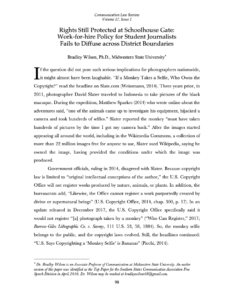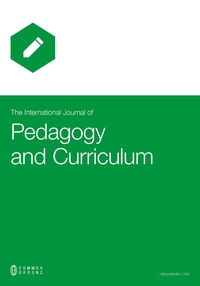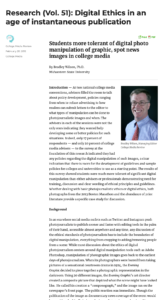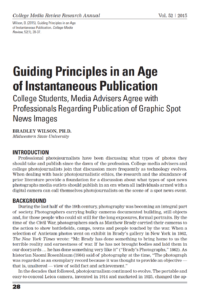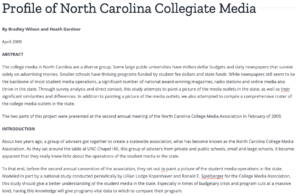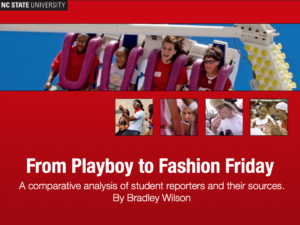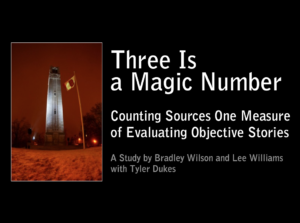Research: Learning New Stuff
Do a search for getting a doctorate. The first two hits are why you should NOT get a Ph.D. And I’ll admit it was an uphill climb. However it gave me a considerable amount of insight into learning — lifelong learning.
I guess I’ve been naturally inquisitive. I look at things and wonder how they work. I walk around campus and want to know why things are the way they are. Science and journalism have similar goals.
But a doctorate is more than just learning. It’s learning new knowledge. Getting a bachelor’s degree means learning, well, a ton of different things, a little about a lot. Admittedly, I wondered why I would ever need some of that stuff. Then the master’s degree is all about becoming a master of something, learning a lot about a little. But the doctorate is different. It means learning new stuff and sharing that new knowledge with that world so others can build upon it.
These are some of the things I’ve learned.

Professionals in the Classroom — “Bringing the Newsroom to the Classroom: Journalism Teachers Find Professional Experience Helps Improve Their Teaching”
Citation: Wilson, Bradley. 2022. “Bringing the Newsroom to the Classroom: Journalism Teachers Find Professional Experience Helps Improve Their Teaching.” The International Journal of Pedagogy and Curriculum 29 (1): 21-33. doi:10.18848/2327-7963/CGP/
Presented at virtual 28th International Conference on Learning, Krakow, Poland, July 7-9, 2021.
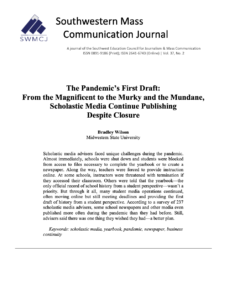
Scholastic Media and Pandemic — “The Pandemic’s First Draft: From the Magnificent to the Murky and the Mundane, Scholastic Media Continue Publishing Despite Closure”
Presented paper at the fall 2021 virtual Southwest Education Council for Journalism and Mass Communication and received Top Six Paper Award.
Citation: Wilson, Bradley. 2022. “The Pandemic’s First Draft: From the Magnificient to the Murky and the Mundane, Scholastic Media Continue Publishing Despite Closure.” Southwestern Mass Communication Journal 37(2).
Photojournalistic Ethics — “Shades of Gray: Print and Video Photojournalists Display Different Ethical Standards”
Presented paper — “Not All Black and White: Print and Video Photojournalists Display Different Ethical Standards” — at peer-reviewed MSU Texas Faculty Forum campus academic forum in Wichita Falls, Texas, Nov. 11, 2019.
Presented paper — “Photojournalistic Ethical Standards: Print and Video Photographers Disagree” — at Broadcast Education Association — On Location regional convention in Boulder, Colorado, Oct. 11, 2019.
Published in the Kansas State University Journal of Media Law and Ethics.
High School Sports Journalism — Just as professional sports reporters are often embedded with teams, high school sports journalists have to go to class with the athletes they cover. However, high school reporters lack the expertise of professionals, leading to an examination about whether high school media coverage of sports was more like public relations or objective journalism. In a survey of high school media advisers, the scholastic sports coverage was found to be a trade-off between objective journalism and positive public relations produced by students who gain valuable skills.
Presented paper — “Coverage of Sports Teams in High School Journalism Programs: Journalism or Public Relations” — at Association for Education in Journalism and Mass Communication national convention in Washington, D.C., Aug. 7, 2018.
CITATION: Hull, Kevin and Bradley Wilson. (2020). “Journalism or Public Relations? Coverage of Sports Teams in High School Journalism Programs,” Journal of Sports Media, 15(1).
Scholastic Media Success — Respondents in a 2017 Gallup poll said they have little confidence in the public schools today with only 36% having a “great deal” or “quite a lot” of confidence in the schools. While the rising tide of mediocrity so often mentioned in educational research pushes for more funding — smaller class sizes and higher teacher salaries, this research and that of others shows money may not be the leading factor in success in a scholastic media environment. When 310 of the most successful scholastic broadcast, yearbook, newspaper and online programs were examined, the qualifications of the teachers, the location of the school and the racial diversity of the school were more likely to predict success than per pupil revenues or low student/teacher ratios.
Presented paper — “About More Than Money: Adviser Qualifications, Racial Makeup of Staff and School Location Predict Scholastic Media Success” — at Southwest Education Council for Journalism and Mass Communication regional convention in Denver, Colorado, Nov. 3, 2018. Top Paper Award.
CITATION: Wilson, Bradley. (2019). “It’s About More Than Money: Adviser Qualifications, Racial Makeup of Staff and School Location Predict Scholastic Media Success,” Southwestern Mass Communication Journal, 34(2).
Law and High School Photojournalist — One person can make a difference and Anthony Mazur is one such person. As a sophomore in high school, he chose to fight unrealistic rules from a wayward administrator. With the support of his parents and the Student Press Law Center, Anthony fought over two years just to be able to take pictures for high school publications and to display them online. The school board got involved and muddied the waters. But what Anthony has done is made all media advisers of how important it is to have a contract in place with students (and sometimes their parents).
Presented paper as part of panel — Fast Times at Free Speech High — at Southern States Communication Association in Austin, Texas, April 7, 2016. “Students do. Monkeys don’t. Texas school board policies, federal copyright laws protect students’ rights” named Top Paper for Free Speech Division.
Presented paper as part of Midwestern State University Faculty Forum, March 16, 2016. “Students do. Monkeys don’t. Texas school board policies, federal copyright laws protect students’ rights.”
Presented paper — “Students do. Monkeys don’t. Texas school board policies, federal copyright laws protect students’ rights.” Presented peer-reviewed, academic paper at the AEJMC Scholastic Journalism Division, Jan. 8, 2016, Poynter Institute for Media Studies, St. Petersburg, Florida.
CITATION: Wilson, Bradley. (2017). “Rights Still Protected at Schoolhouse Gate: Work-for-hire Policy for Student Journalists Fails to Diffuse Across District Boundaries,” Communication Law Review 17(1).
Overpopulation — Findings released by academics in research journals such as The Journal of the American Medical Association to New Media and Society often lead to articles in the mass media, regularly reported in media outlets from The New York Times to USA Today. Abundant research since the 1970s has shown that such coverage in the mass media is then correlated with public opinion and leads to changes in public policy. Normally, such research demonstrates the agenda-setting effects work at the national level on highly salient issues from nuclear power to tobacco use to highway funding. This research shows that agenda-setting research techniques fail to work on overpopulation, an issue that, despite ample academic discussion, appears barely significant in more than 80 years of public opinion polls and barely registers in mass media coverage. Neither media outlets nor poll results indicate any interest in the topic which some scientists says is the top problem facing society today.
Presented paper —”The Press and Coverage of Overpopulation: Media Ignore the most Important Problem facing the World Today” at 15th Annual International Conference on Communication and Mass Media, May 8-11, 2017, Athens, Greece.
CITATION: Wilson, Bradley. (2017). “The Press and Coverage of Overpopulation: Media Ignore What Some Scientists Call the Most Important Problem Facing the World Today,” Athens: ATINER’S Conference Paper Series, No: MED2017-2213.
Photojournalism Ethics — Images from the aftermath of the Boston Marathon bombing fueled an ongoing debate among professionals about the publication of graphic images and whether or not it is acceptable to alter a spot news image digitally. While photojournalists have faced similar discussions since the dawn of the profession, most notably after the publication of graphic images from the Civil War and World War II, professionals and non-photojournalists responding to a 36-question survey after the Boston Marathon agreed that publication of graphic, spot-news images was acceptable as a reflection of what happened at a major news event. Those polled also agreed that manipulation was generally acceptable in photo illustrations but not at all acceptable in hard news images establishing some boundary on when digital manipulation can be used in a photojournalistic setting. Nearly 100 percent agreed that “The highest and strictest standards should be applied to hard-news photographs.” Bringing in concepts such as privacy in regards to the manipulation of specific spot news images, however, professionals disagreed with non-photographers, with non-photographers accepting the blurring of the face of a victim of the bombing and the digital removal of broken bones in a New York Daily News image. In an age of instantaneous publication by anyone, whether they have training in journalistic ethics or not, understanding what media consumers want and need to see will help provide guidance for all media outlets.
Presented paper — “All I Needed to Learn about Photojournalism Ethics I Learned in Kindergarten: Lessons from the Boston Marathon presented at refereed conference, the 2nd annual Cronkite Conference on Media Ethics and Integrity, Nov. 2-4, 2015, Missouri Western State University in St. Joseph, Missouri; top faculty paper award.
CITATION: Wilson, Bradley. (2016). “The Use and Manipulation of Graphic, Spot News Images: Non-photographers More Tolerant of Digital Manipulation,” Journal of Media Law and Ethics, 5(1/2).
EMS Denied Fame — Local newspapers spend many square inches each week covering how long the fire department was on the scene of the most recent house fire or how many burglaries the police department had reported. Analysis of this public safety coverage indicated that, as in prior agenda-setting studies, it is correlated with policy change if only minimally yet continues to shed insight into a seldom-examined area of public health policy. Analysis of hundreds of news articles over a 10-year period in dozens of cities revealed that only about 1 percent of community newspaper coverage was devoted to pre-hospital healthcare — EMS. Subsequent qualitative investigation, which included interviews with EMS officials and newspaper reporters in cities identified with both high levels of coverage and low levels of coverage, found five potential reasons for the minimal coverage including that reporters simply were more interested in police/fire coverage and EMS simply was not on the radar screen of the citizens.
CITATION: Wilson, Bradley. (2016). “EMS Denied 15 Minutes of Fame: Newspaper Coverage of Pre-Hospital Healthcare Related to Policy Change.” In Gholipour, R., & Rouzbehani, K. (Eds.), Social, Economic, and Political Perspectives on Public Health Policy-Making (pp. 20-41). IGI Global. http://doi:10.4018/978-1-4666-9944-1.ch002
Photojournalism Classroom — Teaching ethical principles in a scholastic media classroom poses a challenge for the educator and for the student. There are few right answers and students are often learning a new way to learn, applying values learned at home, through outside-of-school experiences and in other classes rather than from a textbook. This case study, using graphic, spot news images from the Boston Marathon bombing, examined whether students agreed with professional photojournalists or their instructors regarding whether images should be published. Using the Boston Marathon images in a case-study simulation with students role-playing the photojournalists provided instructors with an opportunity to explore concepts of timely publication (being first vs. being accurate) to digital manipulation to privacy. In one case, students agreed significantly with professionals and with advisers in another, providing room for more examination into where students obtain knowledge about their values and beliefs about what can or should be published in a spot news situation.
Presented paper — “Applying Ethical Principles in the Photojournalism Classroom: A Case Study in Values-based Education in a Student Media Environment” presented at refereed conference: Learning Conference, July 9-11, 2015 in Madrid, Spain.
CITATION: “Applying Ethical Principles in the Photojournalism Classroom: A Case Study in Values-Based Education in a Student Media.” In peer-reviewed The International Journal of Pedagogy and Curriculum, 22(4), pp.95-104. Article: Print (Spiral Bound). Published online: July 27, 2015.
Photojournalism Ethics — Since photojournalism became a thing in the 1800s and since the inception of digital photojournalism, professionals have been debating the ethics surrounding the profession. Is it OK to manipulate a scene or is our job just to document reality? Whose reality? Even by shooting images in black-and-white and choosing what to shoot are we manipulating what people see? And can’t digital manipulation go beyond what could be done in a darkroom? The discussions around these questions and many others have resulted in numerous, rather vague sets of guidelines and rules from the National Press Photographers Association and others. I’ve even taken a stab.
- CITATION: Wilson, Bradley. (2015). “Guiding Principles in an Age of Instantaneous Publication.” College Media Review, 52(1), 28-37.
- CITATION: Wilson, Bradley. (2015). “Digital Ethics in an Age of Instantaneous Publication.” College Media Review, 51(1).
Dissertation — Agenda-setting studies are abundant in mass media literature. Since the early 1970s, the methodology conceived by Don Shaw and Max McCombs has been used to study how media coverage of everything from environmental issues to race relations influences public opinion, mostly at the national level. Subsequently, fewer studies have examined whether agenda-setting concepts can be used to correlate media coverage with policy outcomes, and still fewer studies have been used at the local level. By comparing changes in city budgeted allocations with changes in coverage over time, this study finds a limited, long-term relationship between media coverage and policy changes in four areas: public safety, public works, economic development and parks/recreation. Newspapers have a finite amount of influence over policy changes. Further, this study affirms that while citizens continue to depend on newspapers for local government news, local newspaper circulation, market saturation and staff size continue to decline. Finally, this study shows that by 2011, the Great Recession had begun to strain city and town resources with more impact on the Western region of the United States than other areas.
ACKNOWLEDGMENTS | INTRODUCTION | LITERATURE REVIEW | METHODOLOGY |
INITIAL FINDINGS | EXPANDING THE MODEL | CONCLUSIONS | REFERENCES | PDF VERSION
Successfully defended in May of 2012
“Examining the Relationship Between Media Coverage and Policy Outcomes.” Presented at the Western Political Science Association conference, April 21-23, 2011 in San Antonio.
CITATION: Wilson, Bradley. (May 17, 2012). The Impact of Media Agenda Setting on Local Governments. [Doctoral dissertation, North Carolina State University, Raleigh].
A Profile of North Carolina Collegiate Media — The college media in North Carolina are a diverse group. Some large public universities have million-dollar budgets and daily newspapers that survive solely on advertising monies. Smaller schools have thriving programs funded by student fee dollars and state funds. While newspapers still seem to be the backbone of most student media operations, a significant number of national award-winning magazines, radio stations and online media also thrive in the state. Through survey analysis and direct contact, this study attempts to paint a picture of the media outlets in the state, as well as their significant similarities and differences. In addition to painting a picture of the media outlets, we also attempted to compile a comprehensive roster of the college media outlets in the state.
The two parts of this project were presented at the second annual meeting of the North Carolina College Media Association in February of 2009.
From “Playboy” to Fashion Friday — For decades, newspapers have put some emphasis on hiring a diverse staff. In 1999, the American Society of Newspapers Editors said this was not only “ideal” but reflected in the accuracy of coverage of the publication. With analysis over a five-year period, we show that student newspaper staff members do tend to use sources that are convenient and more like themselves than different at least when it comes to their college and gender. Analysis of staff and sources at more universities is necessary to see if racial diversity of the student staff is reflected in racial diversity of the sources used in the media.
Presented at the College Media Association / Associated Collegiate Press convention in Kansas City, fall 2008.
Three is a Magic Number — Textbooks frequently include a number of criteria for evaluating news stories, everything from the form of the lead to the order of quotations and transitions. While numerous texts refer to the ideal types of sources, few give any ballpark figure for an acceptable minimum number of sources. For this study, we didn’t set out to prove what the ideal number was, but we did attempt to determine what the actual number of sources being used was in a case study of a daily student newspaper at a large, state university in North Carolina. We found that the average number of sources in objective stories (news and features) was 2.83, with an average of 1.60 students used as sources on average per article.
Presented at the College Media Advisers fall 2007 convention in Washington, D.C., with Lee Williams, NCSU graduate student




